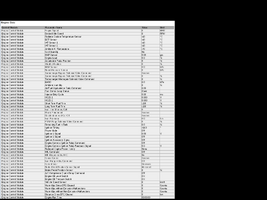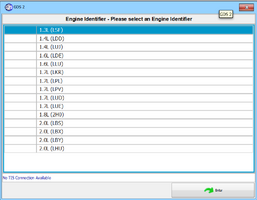I did not make too much progress with the misfire counter, tbh.
Welcome back! Sorry to hear that. For the record, my testing shows that your 2012 Astra J
does appear to use the standard GM misfire PIDs (Mode $22, PIDs $1201 to $1208) as documented in many places, including earlier in this very thread (see
my post #626).
Regards to other pids; thank you much! I don't know what is even possible for the A14NET/B14NET engine? I'm having the standard pids + oil temp and I'm fine with that. Maybe the turbo boost & related data would be useful.
I ran GDS2 and selected the following:
2012, Opel Astra J, with "LUJ" engine
Here is a screenshot of the GDS2-supported PIDs from the "
Engine Data" group:

If you can pick out a few PIDs from that list that you're most interested in monitoring, I will make an effort to decipher the PID number and formula for each one. Since it usually takes a bit of time to determine each PID's meaning and formula, please pick no more than 10 PIDs (by the "Parameter Name" column) from that list for now, ordered to start with the ones that are most important to you.
Here is a raw list of the 51 Mode $22 PID numbers that GDS2 is querying for that list of "Engine Data" for your 2012 Opel Astra J with LUJ engine, in case it's useful for some "exploring" of your own:
Code:
$0004, $0005, $0006, $0007, $000B, $000C, $000D, $000E, $000F, $0010,
$0014, $0015, $001F, $002E, $002F, $0030, $0031, $0033, $0042, $0044,
$0046, $1123, $1124, $1127, $1128, $1130, $1131, $1190, $11C9, $1232,
$1233, $12B1, $12C3, $131F, $136C, $148D, $150C, $1523, $2006, $2020,
$203F, $205A, $2070, $207E, $20D0, $20D4, $2301, $3201, $328B, $328D,
$3298
Mode $22 PIDs $0004 through $0046 are defined (as equivalents to Mode $01 PIDs) by SAE J1979. The ones from $1123 to $3298 are defined by the manufacturer.
Note that when I select a vehicle, GDS2 wants a VIN. So if you can provide me with your VIN, it might give better results in some cases. Feel free to use zero for the last 3 digits of the VIN if you'd like to remain anonymous.
Another thing that is often useful when deciphering a specific vehicle's PIDs is a photo of the sticker with the list of RPO ("Regular Production Options") codes. It's often found in the "glove compartment" or on the inside lid of the trunk. It probably won't matter for the PCM, but it you ever want to probe other nodes on a vehicle, knowing the RPO list can be helpful, so it's good to have that list ready.
Another thing to mention is that both Tech2/Tech2Win and GDS2 sometimes issue initial queries (for a specific vehicle) to which my simulator does
not know how to respond. Typically this is not a problem, but it might cause Tech2/GDS2 to think a vehicle has a different feature or module than it really does. I don't know if this is a factor with your vehicle, but I
do see GDS2 making some of these types of queries early on. For now though, I won't worry about this.
One of my friend has a Z16LET (1.6 turbo, 180hp) engine with automatic gears (I think it's an AF40-6T40 or -6T45), if you could find the transmission oil temperature, I'm sure he would be grateful.
As for your friend's vehicle, I'll need more details. What model year? Is this also an Opel Astra J? A VIN would help here too. I
guessed that his vehicle was a 2012 Opel Astra J. Here is a screenshot of the "Engine Identifier" options in GDS2:

I selected "
1.6L (LLU)" because that seemed to be the closest match for a "
Z16LET" engine, but you should confirm this with him if possible and let me know.
Anyway, when I ran with those assumptions, it looks like your friend's "
Transmission Fluid Temperature" (TFT) PID is one of the standard ones used by GM:
Mode $22, PID $1940, formula "A - 40" in degC. I had my simulator reply to queries for that PID with a controlled value and GDS2 showed it correctly, so it should work for him. Have him try that if you can and please let us know if that works. If not, I'll try again once you report the details of his vehicle.
 drive.google.com
drive.google.com














 That's OK if your friend won't give you his VIN. I ask only because it might give better information in some cases, but I can proceed without it, if needed.
That's OK if your friend won't give you his VIN. I ask only because it might give better information in some cases, but I can proceed without it, if needed.